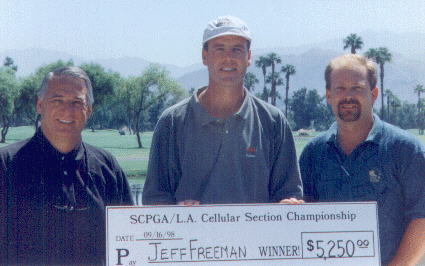Works It's
Magic
 |
|
Works It's Magic |
|
Photo © Gary M. Pinkston 1998
This looks like a pretty simple shot, doesn't it. Well, it wasn't. The sun is directly behind the subjects throwing their faces into shade. Worse still, the primary subject in the middle of the frame is wearing a hat blocking even the skylight from his face whereas the other two subjects are not. Another worst-case scenario in which I had no choice but to enhance the available light. Not having a reflector with me large enough to light up all three people I elected to shoot flash-fill.
Complicating things further, for context, I wanted to affect a change in perspective that would draw the golf course background up closer behind the subjects and, consequently, also needed to increase depth-of-field enough to bring that background into reasonable focus. The solution was to use a 100mm lens. This longer lens cut the apparent distance from subjects to background in half and also allowed me to shoot from a greater distance, thereby increasing DoF.
The greater shooting distance, however, created yet another problem: From twelve feet away my guide number 80 flash could not possibly bring the subjects up the three EV required to get a decent balance against the bright ambient sunlight. This problem was solved by moving the strobe off-camera onto a short stand placed about five feet in front of the subjects and then shooting over the top of it. From this shorter distance and low angle the flash was able to fill-in under the hat very nicely. My flash is focusable so pinching it down to its narrowest beam-width also threw more light onto the center subject with the hat than it did the non-hatted subjects on either side. Shooting flash-fill not only brought the high contrast scene into sunny-side vs. shady-side balance but also bought me two stops in aperture resulting in even greater depth-of-field.
Hopefully you are beginning to understand how all the variables work together to produce a desired result. It all starts with your concept. You have to know what you want first and then know how to manipulate the variables to achieve that desired outcome.